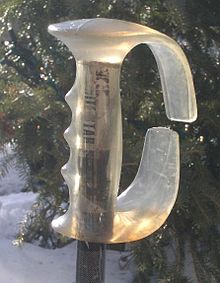Ski pole
A ski pole is a stick that - now usually in pairs - is used in almost all types of skiing for supporting, pushing, straightening, maintaining balance and supporting movement (see use of poles ). Some types of skiing, such as fun carving and ski jumping , do without ski poles.
Historical
In the early days of alpine skiing , a single stick made of wood with a length of up to 2.50 m was used. The athlete held the stick in both hands and used it on the inside of the curve while driving.
In Nordic skiing , where skiers were more likely to move across flat landscapes, there were two sticks with plates based on the snowshoe principle from the start . These sticks were soon equipped with leather straps.
Design
Today ski poles are mostly hollow rods made of light metal , fiber-reinforced plastic or combinations of these materials. The diameter of the rod is usually in a range of one to two centimeters, typical lengths are in the range from waist-high in alpine skiing to eye-high in the skating technique in cross-country skiing. For downhill skiing, the ski poles are curved so that they can be held against the body in a particularly aerodynamic manner in the downhill squat . The shape of the downhill ski poles was developed by Erwin Stricker .
A handle is attached to the upper end of the ski pole . A holding loop or a comparable device is usually attached to the handle, which ensures that the stick can be briefly loosened or released without losing it.
The lower end of the ski pole is usually conically shaped over a length of 5 to 10 cm and ends in a hard point. About a hand's breadth above the tip there is a so-called plate that prevents the stick from penetrating too deeply into the snow . The plate has - depending on the purpose - different shape and size. Downhill skiing plates are usually round with a few centimeters in diameter. Plates for use in deep snow are often star-shaped with a diameter of 10–15 cm. Plates for cross-country skiing are asymmetrically shaped and usually have little surface in front of the pole when viewed in the direction of travel.
A special form of the ski pole is the telescopic pole, which can be adjusted in length and pushed together for easy transport. Telescopic poles are mainly used by ski tourers and (snowshoe) hikers.
swell
- ^ Daily newspaper Dolomiten, No. 226/2010 of September 29, 2010, p. 5.

